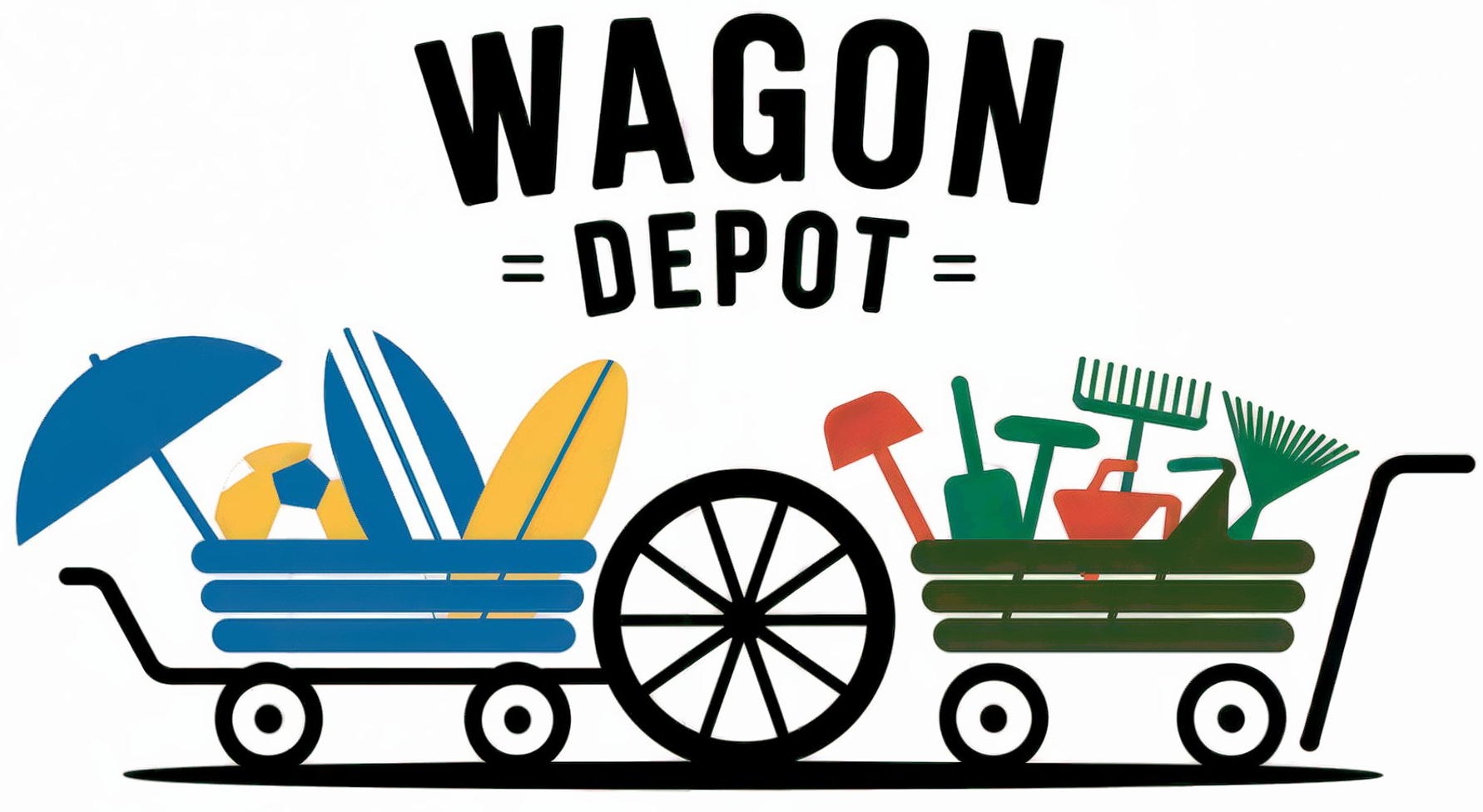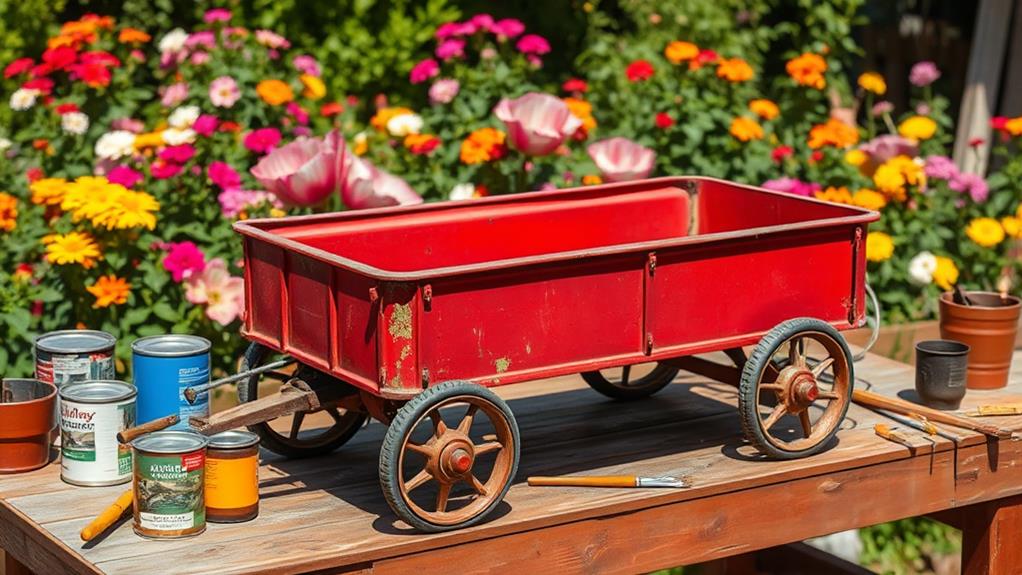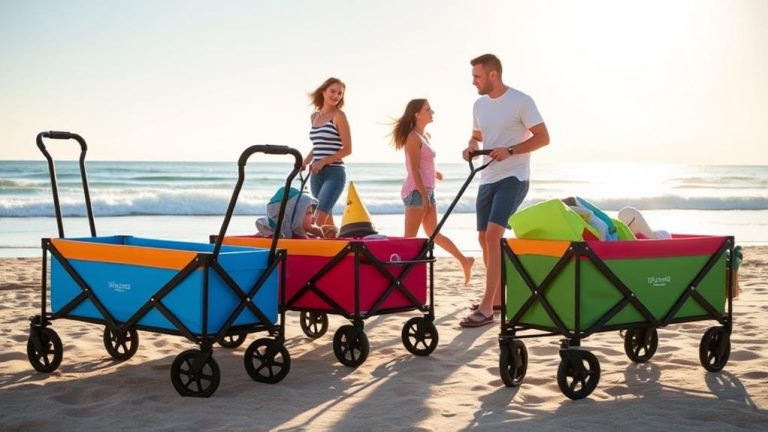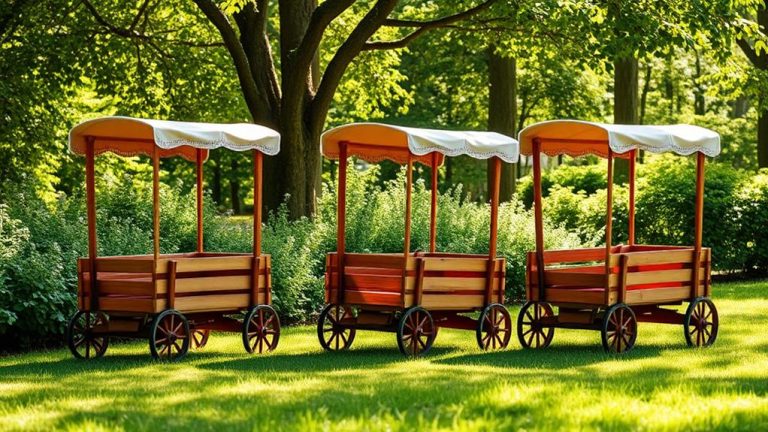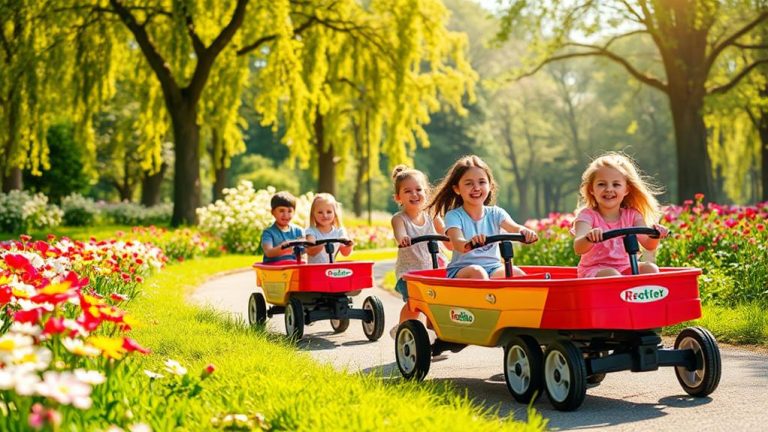Restoring vintage metal wagons for kids is both an exciting and fulfilling project. Start by evaluating the wagon’s condition; look for rust, dents, and broken parts. Gather vital tools like screwdrivers and pliers for disassembly. Clean the wagon thoroughly using mild detergent to prepare the surface for painting. Remove rust with sandpaper or chemical treatments, then apply a metal primer. Choose lively, non-toxic paint for a joyful finish, and don’t forget a clear coat for durability. Ensuring safety throughout is imperative, so pay attention to sharp edges and loose components. Continue onward to reveal even more detailed tips and tricks! For a smoother ride, inspect and lubricate the wheels, replacing any that are too worn or damaged. Reassemble the wagon carefully, ensuring all nuts and bolts are secure to prevent any hazards. For expert tips for antique wagons, consider researching restoration guides or consulting professionals who specialize in vintage toy refurbishing.
Assessing the Wagon's Condition
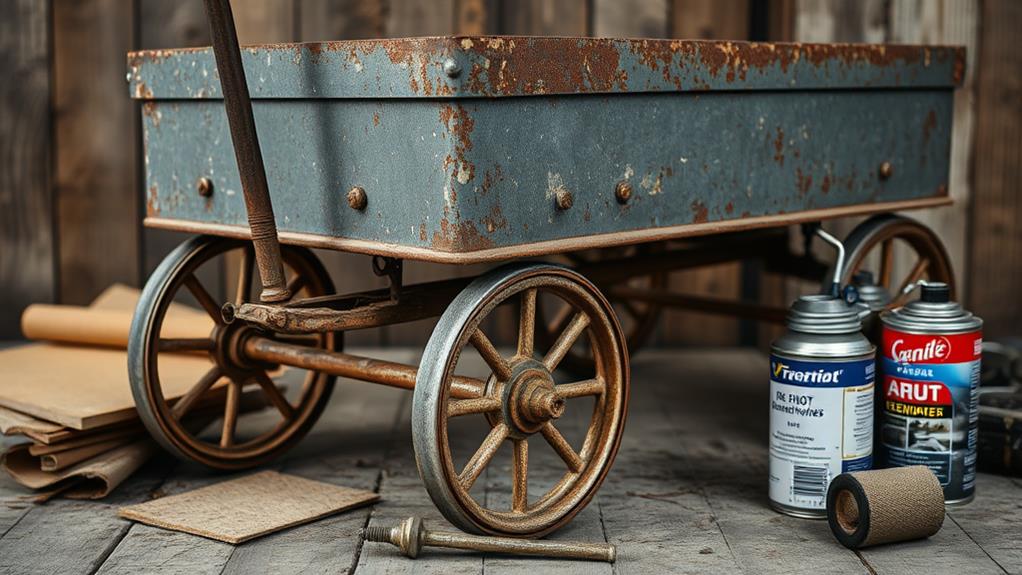
When you're ready to plunge into restoring a vintage metal wagon, the first step is evaluating its condition. Start by examining the overall structure; check for rust, dents, and any signs of wear. A wagon's vintage design tells a story, and it's essential to uncover what that story entails. Inspect the wheels and axles for functionality—are they intact or do they need replacement? Note any broken parts or missing pieces, as these will directly affect your restoration techniques.
Next, assess the paint. Is it chipped or faded? Although some might embrace the patina of age, others may prefer a fresh look. Decide if you want to strip the old paint or simply touch it up. Pay attention to the interior as well; a clean, smooth surface inside will improve both aesthetics and safety for kids.
Gathering Essential Tools
Before you start restoring your vintage metal wagon, you'll need to gather some crucial tools that will make the process smooth and efficient. Think about the necessary hand tools like screwdrivers and wrenches, along with paint and finishing supplies to give your wagon that fresh look. Don't forget to prioritize safety gear, ensuring you're protected during the process of breathing new life into this cherished piece of childhood nostalgia.
Necessary Hand Tools
The joy of restoring vintage metal wagons for kids lies not just in the transformation but likewise in the tools you gather for the task. Choosing the right tools can make all the difference in your restoration expedition. Start with the must-have tools: a set of screwdrivers, pliers, and wrenches. These will help you disassemble the wagon and replace any worn-out parts.
You'll additionally need a hammer, ideally a rubber mallet, to carefully work on any dents without damaging the metal. A good pair of wire cutters is crucial for any rusted or broken components. As you gather your supplies, keep these tool selection tips in mind: prioritize quality, look for ergonomic designs, and confirm versatility.
A sturdy workbench will serve as a solid foundation for your project, whereas safety goggles and gloves will keep you protected. A drill can come in handy for any modifications or reinforcements you might consider making. By assembling these necessary hand tools, you're not just preparing for a project; you're paving the way toward creating something truly special for the kids in your life. Let the adventure begin!
Paint and Finishing Supplies
After gathering your hand tools, the next step in restoring vintage metal wagons involves selecting the right paint and finishing supplies. This is where you can truly express your creativity and bring that wagon back to life. Start by considering your color selection; lively hues can evoke nostalgia, whereas muted tones may offer a more classic feel. Think about the finish types as well—do you want a glossy look, or perhaps a matte finish for a vintage vibe?
Here's a list of crucial supplies you'll need for a successful project:
- Metal primer: Guarantees better paint adherence and longevity.
- Acrylic or enamel paint: Choose based on your desired finish and durability.
- Clear coat: Protects your paint job and adds shine.
- Paintbrushes and rollers: Different sizes help with detailed work and larger areas.
- Sandpaper: Helps prep the surface for a smooth application.
Embrace the freedom of choice in your color selection and finish types, and let your personality shine through as you restore that cherished wagon!
Safety Gear Essentials
When plunging into the restoration of vintage metal wagons, don't underestimate the significance of safety gear. You're not just working with metal; you're crafting a safe haven for kids to enjoy. Start with a sturdy pair of work gloves to protect your hands from sharp edges and splinters. A good pair of safety goggles is vital, too—these will shield your eyes from dust and debris, especially during sanding or painting.
Next, consider a dust mask. You'll want to avoid inhaling any particles that could be harmful. If you're working with chemicals, like paint strippers, make sure you have a respirator that matches the material's safety requirements.
Lastly, if you're working in an environment with potential hazards, wear steel-toed boots. They'll protect your feet from heavy objects. Remember, child supervision is critical here. Keep your little ones at a safe distance while you're restoring their future ride, making certain they're entertained and away from any tools or chemicals.
Cleaning and Preparing the Surface
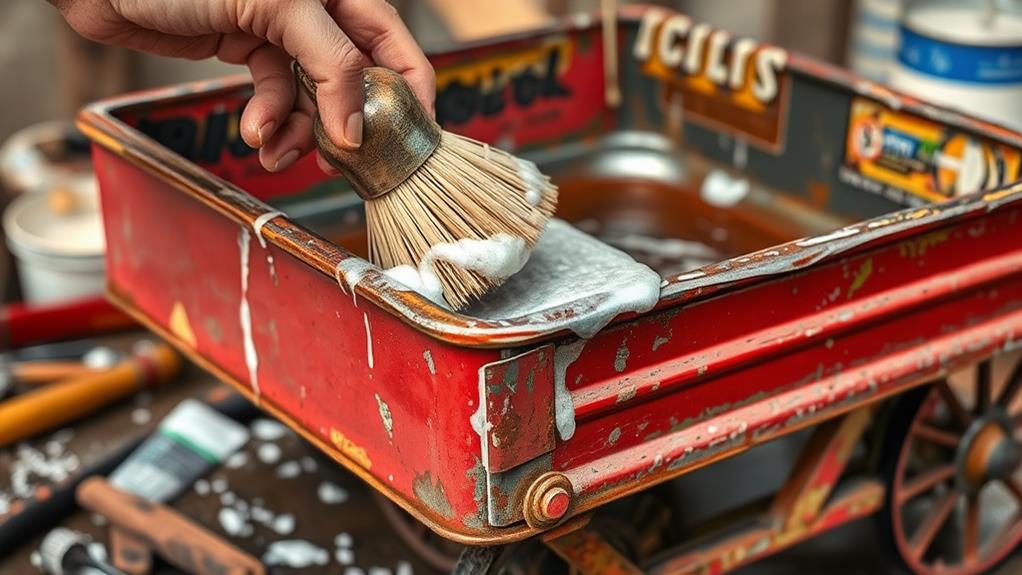
Before plunging into the restoration process, it is vital to focus on cleaning and preparing the surface of your vintage metal wagon. Proper surface preparation sets the foundation for a successful restoration. Start by gathering your cleaning supplies; this will make the process smoother and more enjoyable.
Here are some key items to have on hand:
- Mild detergent or soap
- Soft-bristle brush or sponge
- Steel wool (for tougher grime)
- Rags or microfiber cloths
- Water
Begin by rinsing off loose dirt and debris. Next, apply your chosen cleaning solution using a soft-bristle brush or sponge, ensuring you reach into crevices. For stubborn areas, gently scrub with steel wool, but be careful not to damage the metal. Once you've cleaned every inch, rinse thoroughly with water to remove any soap residue.
Repairing Damage and Rust
Before you start fixing up that vintage wagon, it's essential to assess its structural integrity to guarantee it's safe and functional for your little ones. Once you've identified any weak spots, you'll need to tackle rust removal with effective techniques like sanding or using a rust converter, securing a solid foundation for your restoration. This step isn't just about aesthetics; it's about preserving a piece of nostalgia for future generations to enjoy.
Assessing Structural Integrity
Evaluating the structural integrity of vintage metal wagons is crucial to guarantee they're safe and enjoyable for kids. Start with a thorough structural inspection to identify any weak points. Look for bends, cracks, or corrosion that could compromise the wagon's durability. Confirm that the frame is intact, as this will help maintain proper weight distribution when your little ones are riding.
To help you assess the wagon effectively, consider these key points:
- Check for any loose or missing screws and bolts.
- Inspect the wheels for wear and verify they roll smoothly.
- Look underneath for signs of rust or damage that may not be visible from the top.
- Test the strength of the handle; it should be firmly attached and able to withstand pulling.
- Consider the overall balance of the wagon; a well-distributed load will improve safety during use.
Rust Removal Techniques
When tackling rust on your vintage metal wagon, you'll find that the right techniques can make all the difference in restoring its charm and functionality. Start by evaluating the severity of the rust. For light rust, you can often use abrasive techniques like sandpaper or steel wool. Gently rub the affected areas, being careful not to damage the surrounding paint. If the rust is deeper, consider chemical methods, such as rust removers that contain phosphoric acid. These can effectively convert rust into a stable compound, making it easier to clean.
After applying a chemical treatment, let it sit for the recommended time, then scrub away the residue. Rinse thoroughly and dry the metal to prevent further rust formation. Once you've removed as much rust as possible, be sure to apply a primer designed for metal surfaces. This not only protects against future rust but likewise provides a solid base for any paint you plan to apply.
Ultimately, the choice between abrasive techniques and chemical methods depends on your comfort level and the wagon's condition. Embrace the restoration process, and your vintage wagon will regain its former glory, ready for new adventures.
Painting and Finishing Touches
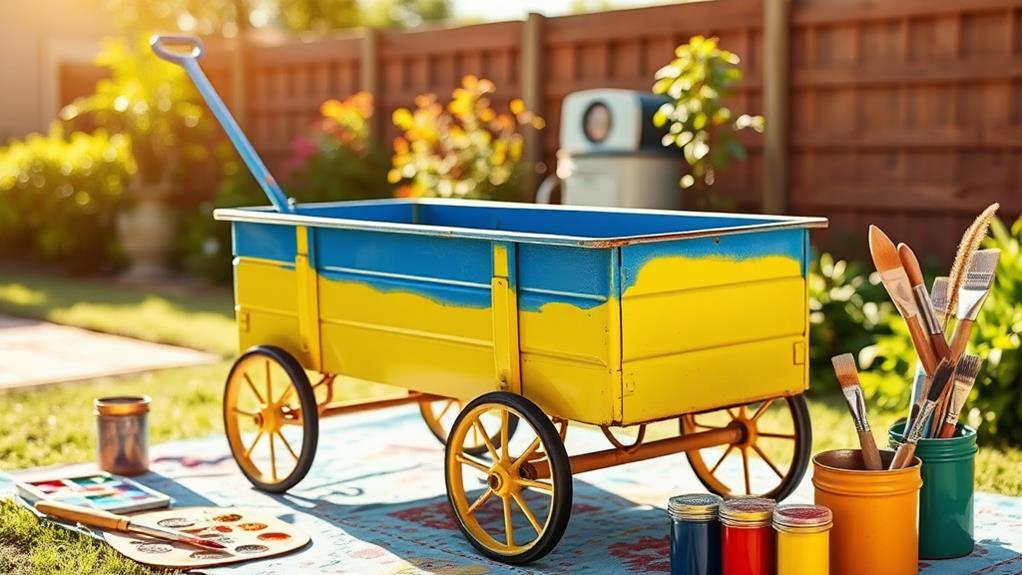
The lively colors of freshly painted metal wagons evoke nostalgia and joy, making the painting process one of the most rewarding steps in restoring these beloved childhood treasures. Start by choosing the right color selection that resonates with your vision. Whether you opt for bold reds, pastel blues, or classic greens, let your creativity shine.
Once you've settled on your colors, consider the finish types. A glossy finish can create a radiant look, whereas a matte finish gives a vintage charm. Here's how to proceed:
- Clean the surface thoroughly to remove any dust or debris.
- Apply a primer suitable for metal to guarantee better paint adhesion.
- Use high-quality spray paint or brush-on paint to achieve an even coat.
- Allow adequate drying time between coats for a smooth finish.
- Seal your masterpiece with a clear coat to improve durability and shine.
This isn't just about painting; it's about bringing back memories and creating something beautiful. Immerse yourself in this colorful adventure, and let each stroke remind you of carefree days spent playing with your cherished wagon. Enjoy the freedom of expression, and watch your wagon transform!
Safety Considerations for Kids
Before your restored vintage metal wagon hits the playground, it's vital to prioritize safety considerations for kids. First, confirm that all materials used in the restoration are safe. Look for non-toxic paints and finishes that won't harm your child if they come into contact with them. Rust should be fully addressed, as sharp edges can pose serious risks.
Next, child supervision is important when your little ones are enjoying their new ride. Always keep an eye on them, especially if they're using the wagon on uneven surfaces or around other children. This oversight can prevent accidents and guarantee everyone has a great time.
Also, check the wagon's wheels and axles to verify they're secure and functioning smoothly. Loose components can lead to tipping or rolling away unexpectedly, which can be dangerous.
Frequently Asked Questions
What Are the Best Materials for Replacing Damaged Wagon Parts?
When considering the best materials for replacing damaged wagon parts, you'll want to focus on durable options that improve the wagon's charm. Utilize upcycling techniques to repurpose metal or wood from old furniture. For restoration tools, a reliable set of wrenches and a soldering iron can make repairs easier. Don't forget to sand surfaces and apply rust-resistant paint for longevity. With passion and creativity, you'll breathe new life into every piece you restore.
How Can I Identify the Age of My Vintage Wagon?
To identify the age of your vintage wagon, start by researching wagon history and popular vintage brands like Radio Flyer or American Flyer. Did you know that certain models can be traced back over 100 years? Look for distinct features: logos, wheel designs, and materials used. Check for any serial numbers or marks, as these can pinpoint the production year. This process not only reveals age but additionally connects you to a cherished past.
Is It Safe to Use Modern Paints on Vintage Wagons?
When considering modern paint safety for your vintage wagon, it's vital to choose non-toxic, low-VOC options. Traditional finishes may contain harmful chemicals, so using modern alternatives can offer a safer solution. Nevertheless, always test a small area first to guarantee compatibility with the vintage wagon finishes. You want to preserve the charm as you make sure it's safe for children. Balancing nostalgia with safety lets you enjoy your wagon's beauty without worry.
Where Can I Find Replacement Parts for My Vintage Wagon?
If you're looking for replacement parts for your vintage wagon, start by exploring vintage wagon suppliers who specialize in restoration. They often have the unique components you need. Furthermore, check out online parts marketplaces like eBay or Etsy, where you can find both new and used parts from fellow enthusiasts. Don't hesitate to connect with vintage wagon communities; they can provide valuable leads and support on your restoration expedition.
How Do I Maintain the Restored Wagon for Longevity?
Envision your restored wagon glinting in the sun, a lively relic ready for adventure. To maintain its beauty, adopt gentle cleaning techniques—use mild soap and soft cloths to avoid scratches. After each use, dry it thoroughly to prevent rust. For storage, keep it in a cool, dry place, away from harsh elements. Regularly check for loose parts or chips in the paint, ensuring your wagon stays a cherished companion for years to come.
